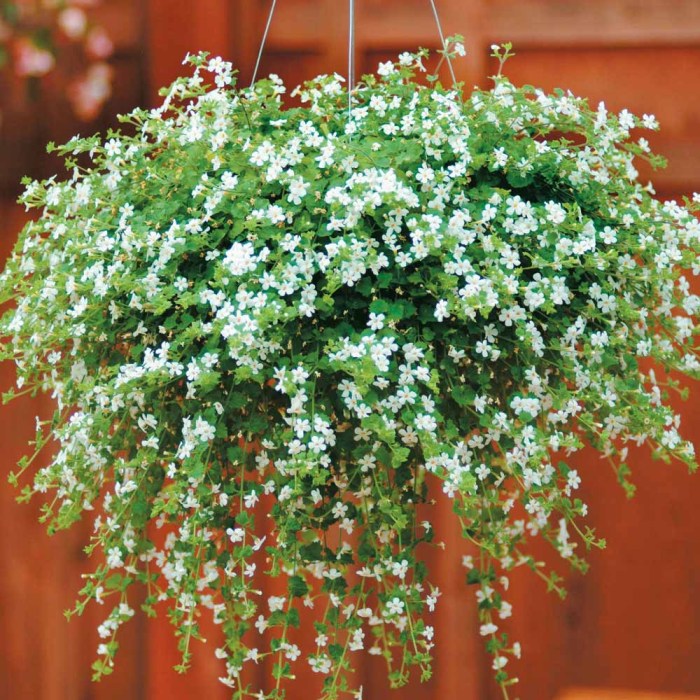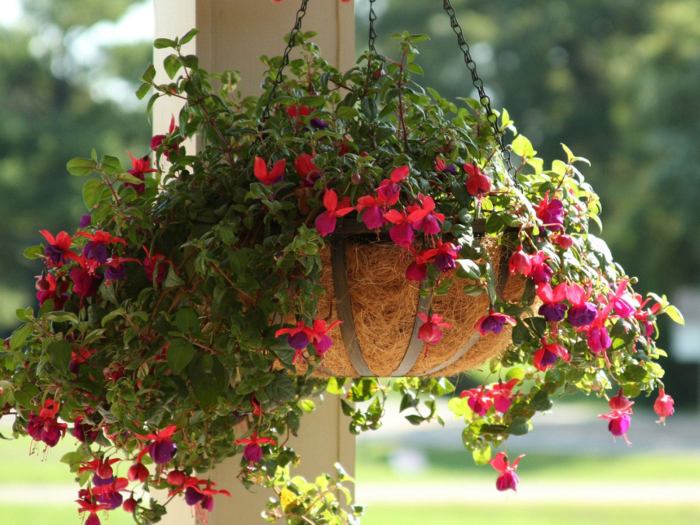Hanging plants that like shade – Step into the realm of hanging plants that thrive in the embrace of shade, where nature’s artistry unfolds in vibrant hues and graceful forms. This comprehensive guide unveils the secrets to cultivating these botanical wonders, transforming your shaded nooks into verdant havens.
From understanding their environmental needs to mastering hanging techniques, discover the essential elements for nurturing these shade-loving companions. Explore their unique benefits and practical applications, as they not only beautify your surroundings but also purify the air and create a sense of tranquility.
Shade-Tolerant Hanging Plant Species: Hanging Plants That Like Shade
Hanging plants can add a touch of greenery and freshness to any indoor space, even those with limited natural light. Several plant species thrive in shady conditions, making them ideal for north-facing windows, dimly lit rooms, or shaded patios.
Here’s a list of some popular shade-tolerant hanging plant species that will bring a touch of nature to your home:
Common Hanging Plant Species
- Spider Plant (Chlorophytum comosum):A low-maintenance plant known for its long, arching leaves with variegated patterns.
- Pothos (Epipremnum aureum):Also known as Devil’s Ivy, this trailing plant has heart-shaped leaves that come in a variety of colors, including green, yellow, and white.
- Snake Plant (Sansevieria trifasciata):A succulent with upright, sword-like leaves that tolerate neglect and low light conditions.
- ZZ Plant (Zamioculcas zamiifolia):A low-maintenance plant with glossy, dark green leaves that can tolerate extreme shade and drought.
- Ferns:Ferns, such as Boston Fern (Nephrolepis exaltata) and Maidenhair Fern (Adiantum capillus-veneris), thrive in humid, shady environments and add a touch of elegance to any space.
Environmental Considerations

The well-being of hanging plants in shady areas is highly influenced by environmental factors, particularly light intensity and duration, temperature, and humidity. Understanding these factors is crucial for ensuring optimal growth and preventing potential problems.
Light is essential for photosynthesis, the process by which plants convert sunlight into energy. For hanging plants in shady areas, light intensity and duration are particularly important. Insufficient light can lead to slow growth, yellowing leaves, and stunted development. It is important to assess the amount of light available in the chosen location and supplement with artificial lighting if necessary.
Temperature
Temperature plays a significant role in the growth and development of hanging plants. Most shade-tolerant plants prefer moderate temperatures between 60°F (15°C) and 75°F (24°C). Extreme temperatures, either too hot or too cold, can cause stress, damage, and even death.
It is important to protect plants from sudden temperature changes and drafts.
Humidity
Humidity levels are also important for hanging plants in shady areas. Many of these plants prefer higher humidity levels to prevent drying out. Misting the plants regularly or using a humidifier can help increase humidity. However, it is important to avoid overwatering, as this can lead to root rot and other problems.
Hanging Techniques and Aesthetics

Hanging shade-tolerant plants adds a touch of greenery and visual interest to both indoor and outdoor spaces. With careful planning and creative execution, you can create stunning displays that complement your home décor and landscaping designs.Various hanging mechanisms are available to suit different plant species and environments.
Hanging plants that like shade add a touch of greenery and life to any outdoor space. For those looking to create a lush and inviting atmosphere, understanding how to hang plants outdoor is essential. With the right techniques, hanging plants that like shade can thrive and bring a touch of nature to any outdoor setting.
Macrame hangers, for instance, provide a bohemian touch and are ideal for small to medium-sized plants. Woven baskets offer a more rustic charm and can accommodate larger plants. Metal chains and hooks are durable options for heavy plants or outdoor use.Incorporate
hanging plants into your home décor by suspending them from ceiling hooks or plant stands. Group plants of varying heights and textures to create a lush and layered effect. For outdoor spaces, hang plants from pergolas, arbors, or tree branches to create shaded oases or vertical gardens.
Care and Maintenance

Maintaining hanging plants in shady conditions requires specific care and maintenance practices to ensure their optimal growth and well-being. Understanding the watering, fertilizing, and pruning requirements is crucial, along with recognizing common pests and diseases that may affect these plants.
Watering, Hanging plants that like shade
Watering is a critical aspect of caring for hanging plants in shady areas. Due to the reduced sunlight, these plants may not require as much water as their counterparts in sunnier locations. Overwatering can lead to root rot and other issues.
It is essential to check the soil moisture regularly and water only when the top inch or two of soil feels dry to the touch. During the winter months, reduce watering frequency to prevent overwatering.
Fertilizing
Fertilizing is another important aspect of maintaining hanging plants in shady conditions. These plants may require less fertilizer than those in sunnier areas. A balanced, slow-release fertilizer applied once a month during the growing season is generally sufficient. Avoid over-fertilizing, as this can damage the plants.
Pruning
Pruning is essential for maintaining the shape and size of hanging plants in shady conditions. Remove any dead, damaged, or diseased leaves or stems to encourage new growth. Pruning can also help improve air circulation and reduce the risk of pests and diseases.
Hanging plants that thrive in shady areas add a touch of greenery to indoor spaces. If you’re looking for a convenient and stylish way to display them, consider hanging baskets bunnings . These baskets come in a variety of sizes and designs, making them suitable for any decor.
Whether you prefer a classic wicker look or a modern metal finish, you’ll find the perfect option to complement your hanging plants that like shade.
When pruning, use sharp, clean shears to make clean cuts.
Common Pests and Diseases
Hanging plants in shady conditions may be susceptible to certain pests and diseases. Some common pests include aphids, mealybugs, and scale insects. These pests can be controlled using insecticidal soap or neem oil. Common diseases include root rot, powdery mildew, and leaf spot.
These diseases can be prevented by ensuring proper drainage and avoiding overwatering.
For those seeking to add a touch of greenery to dimly lit areas, shade-loving hanging plants offer a perfect solution. Their ability to thrive in low light conditions makes them ideal for rooms with limited natural illumination. To ensure optimal hydration, consider investing in a hanging plant waterer bunnings . These devices provide a convenient and efficient way to water hanging plants, ensuring they receive the necessary moisture to flourish in their shady habitats.
Monitoring Plant Health
Regularly monitoring the health of hanging plants in shady conditions is essential. Look for signs of pests, diseases, or nutrient deficiencies. Address any issues promptly to prevent further damage to the plants. If you notice any changes in the plant’s appearance or growth patterns, consult a gardening professional for assistance.
Unique Uses and Benefits
Shade-tolerant hanging plants offer a myriad of aesthetic and practical benefits, transforming shaded areas into vibrant and functional spaces. Their lush foliage creates a sense of privacy, screening unsightly views and providing a verdant backdrop for outdoor gatherings.
Enhancing Air Quality
These plants act as natural air purifiers, removing harmful toxins and pollutants from the air. Studies have shown that certain species, such as ferns and spider plants, can effectively reduce levels of formaldehyde, benzene, and other volatile organic compounds (VOCs).
Vertical Gardens and Space-Saving Solutions
Hanging shade-tolerant plants are ideal for creating vertical gardens, maximizing space utilization in compact areas such as balconies and small patios. Their trailing vines and cascading foliage add vertical interest and greenery to otherwise bare walls or fences.
Final Conclusion

Embark on a journey of botanical discovery, where hanging plants that like shade become the protagonists of your indoor and outdoor spaces. With the knowledge gained from this guide, you can create breathtaking displays that bring a touch of nature’s magic to every corner of your shaded realm.
Key Questions Answered
What are some popular hanging plants that like shade?
Spider plants, pothos, philodendrons, ferns, and peperomias are just a few examples of shade-tolerant hanging plants.
How often should I water hanging plants in shady areas?
Water when the top inch of soil feels dry to the touch, adjusting frequency based on temperature and humidity levels.
Can hanging plants help improve air quality?
Yes, many hanging plants are known for their air-purifying abilities, removing toxins and increasing oxygen levels.